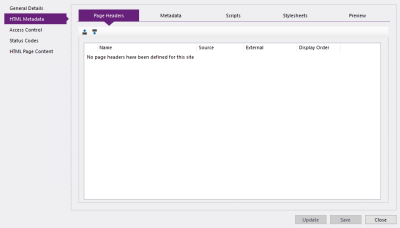View and manage supplementary content assigned to the selected page. The initial view of this panel is the Page Headers tab, where you can see all metadata properties that have been added to the page.
Metadata does not typically appear on the page itself, but it can be read and utilised by systems that use the page in some way, such as web browsers and search engines.
Implementation:
- Switch to the HTML Metadata panel when editing a page.
- Make sure the Page Headers tab is displayed.
This tab shows a list of items that have been added to the selected page. When you add anything using the other tabs in this panel, they will appear here.
- Switch to the Metadata tab.
- Click
 to add metadata properties to the selected page.
to add metadata properties to the selected page. - Use the drop-down menu to select a type for the new meta-tag. The rest of the fields in this dialog will depend on the type you select.
There are several types of metadata you can add:
- Meta Tag Named Property - This should be used for all other types of metadata. When creating this type of tag, you'll be asked to specify a valid tag name to accompany its value. Examples of valid meta-tags include the page's description, the name of its author, and keywords used when searching for it.
- Meta Tag Charset - Define the character encoding for the page, e.g. UTF-8. This is the preferred method used in modern HTML beginning with HTML5, although http-equiv can be used instead.
- Meta Tag Http Equiv - This is another method of defining the character encoding for pages, particularly those written in earlier versions of HTML beginning with 4.01.
Unlike the Scripts and Stylesheets managed via other tabs in this panel, Meta-tags are not site-wide resources - they only affect the page (or master page) to which they are assigned.
- Provide a Name for the new tag.
Certain tag's require you to type a valid tag name here. If you select other types the name will be assigned automatically.
- Assign a Value to the tag.
if you selected Meta Tag Charset as the tag type for example, you should specify a valid character set such as UTF-8.
- (Optional) Modify the properties of a tag by double-clicking it, and repeating steps 5-7.
- Click Save to apply the new meta-tag to the selected page.
- Switch to the Scripts tab and StyleSheets tab, respectively.
- Select as many of your site's scripts and stylesheets you want to be applied to the selected page, by ticking the checkbox in each of the tabs, next to the ones you want to apply.
Both of these tabs will let you view the scripts and stylesheets the selected page has inherited from its master page, highlighted in green. Because these are determined by the master page, you can not modify them for individual pages using this interface.
All selected scripts and stylesheets will appear in the Page Headers tab. The options you select here will override any conflicting settings in the associated master page.
- Switch to the Preview tab to view the HTML code that will be added to the page's header code.
- (Optional) Click Update to save and publish your changes without closing the active window.
- (Optional) Click Save to publish your changes to the site, and close the active window.

